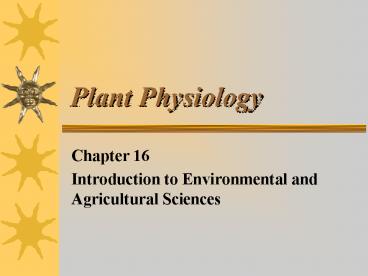Plant Physiology - PowerPoint PPT Presentation
1 / 17
Title:
Plant Physiology
Description:
Plant Physiology. Chapter 16. Introduction to Environmental and Agricultural Sciences ... As plants grow to maturity, the cells are produced, divide, grow ... – PowerPoint PPT presentation
Number of Views:9642
Avg rating:5.0/5.0
Title: Plant Physiology
1
Plant Physiology
- Chapter 16
- Introduction to Environmental and Agricultural
Sciences
2
Introduction
- As plants grow to maturity, the cells are
produced, divide, grow become specialized
organs. - Stems, leaves, roots, flowers, fruits, seeds.
- Physiology study of how these organs function
and the complex chemical processes that permit
the plant to live, grow and reproduce.
3
Major Parts of a Plant
4
Photosynthesis
- Most important life-sustaining process
- Without photosynthesis, maintenance of life on
this planet would not exist - Plants need carbon dioxide to manufacture food
- Animals need oxygen to live
- Photosynthesis permits animals and plants to live
and support each other
5
Photosynthesis
- Photosynthesis is a series of processes in which
solar (light) energy is converted to chemical
energy in the form of a simple sugar. - Chlorophyll and chloroplasts are essential to
this process. - Chlorophyll is the substance that gives plant
leaves their green color.
6
Photosynthesis
- Chloroplasts are small membrane bound bodies
inside the cell that contain the green
chlorophyll pigment. - Chloroplasts are the actual site where solar
(light) energy is converted into stored
energy-simple sugars.
7
Photosynthesis
- Photosynthesis is the conversion of carbon
dioxide and water in the presence of light
(energy) and chlorophyll into glucose, oxygen and
water.
8
Rate of Photosynthesis
- The rate of photosynthesis varies with the light
intensity, temperature and concentration of
carbon dioxide in the atmosphere. - Light Intensity is the quality of light, or
brightness of light. - Photosynthesis occurs best in a temperature range
of 65-85?F. - Extreme temperatures slow down or stop the
process completely. - A lack of carbon dioxide can be a limiting factor
in the photosynthesis process.
9
Respiration
- All living cells carry on the process of
respiration. - Respiration is the process by which living cells
(plant or animal) take in oxygen and give off
carbon dioxide. - Respiration occurs both day and night.
10
Respiration
- Respiration is a breaking down process
- Uses sugars starches produced by photosynthesis
and converts them into energy.
11
Photosynthesis vs. Respiration
12
Transpiration
- Transpiration is the process by which a plant
gives up water vapor to the atmosphere. - Water loss takes place primarily through the leaf
stoma. - A plant transpires 90 of the water that enters
through the roots. - About 10 of the water that enters from the roots
is used in chemical processes and in the plant
tissues.
13
Transpiration
- Functions of the water include transporting
minerals through the plant, cooling the plant,
moving sugars and plant chemicals and maintaining
turgor pressure. - Turgor means swollen or stiffened condition as a
result of being filled with liquid. - When plants do not have enough water, turgor
pressure is lost and the plant starts to wilt.
14
Transpiration
15
How is transpiration affected?
- Humidity
- Humidity Transpiration
- Wind Other air movement
- Air Movement Transpiration
- Temperature
- Temperature Transpiration
16
How is transpiration affected?
- During dry weather, transpiration often causes
the plant to lose water faster than it can be
replace by the root system. - When this occurs, the guard cells will close to
slow down the rate of transpiration. - Enables the plant to preserve the water it
contains
17
How is transpiration affected?































